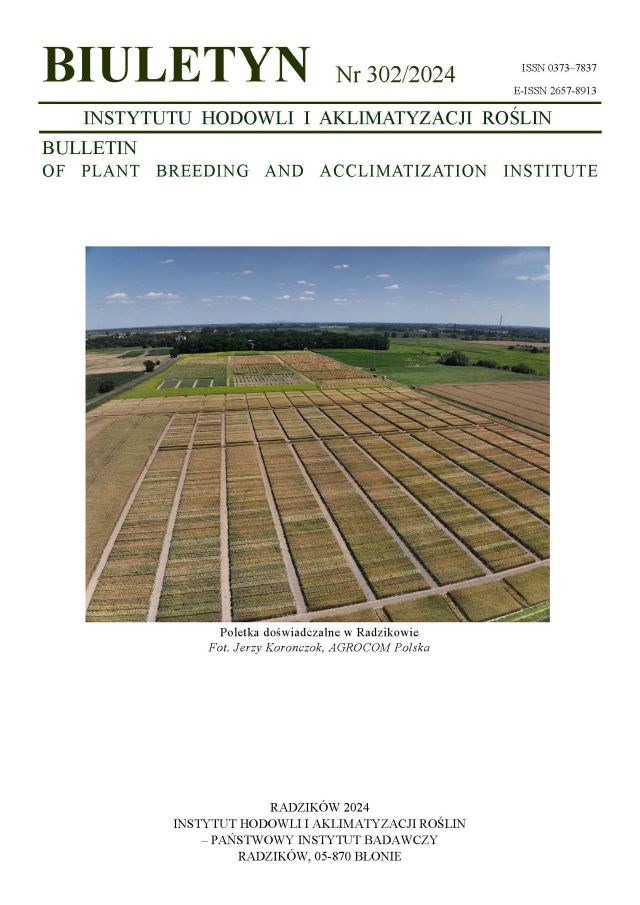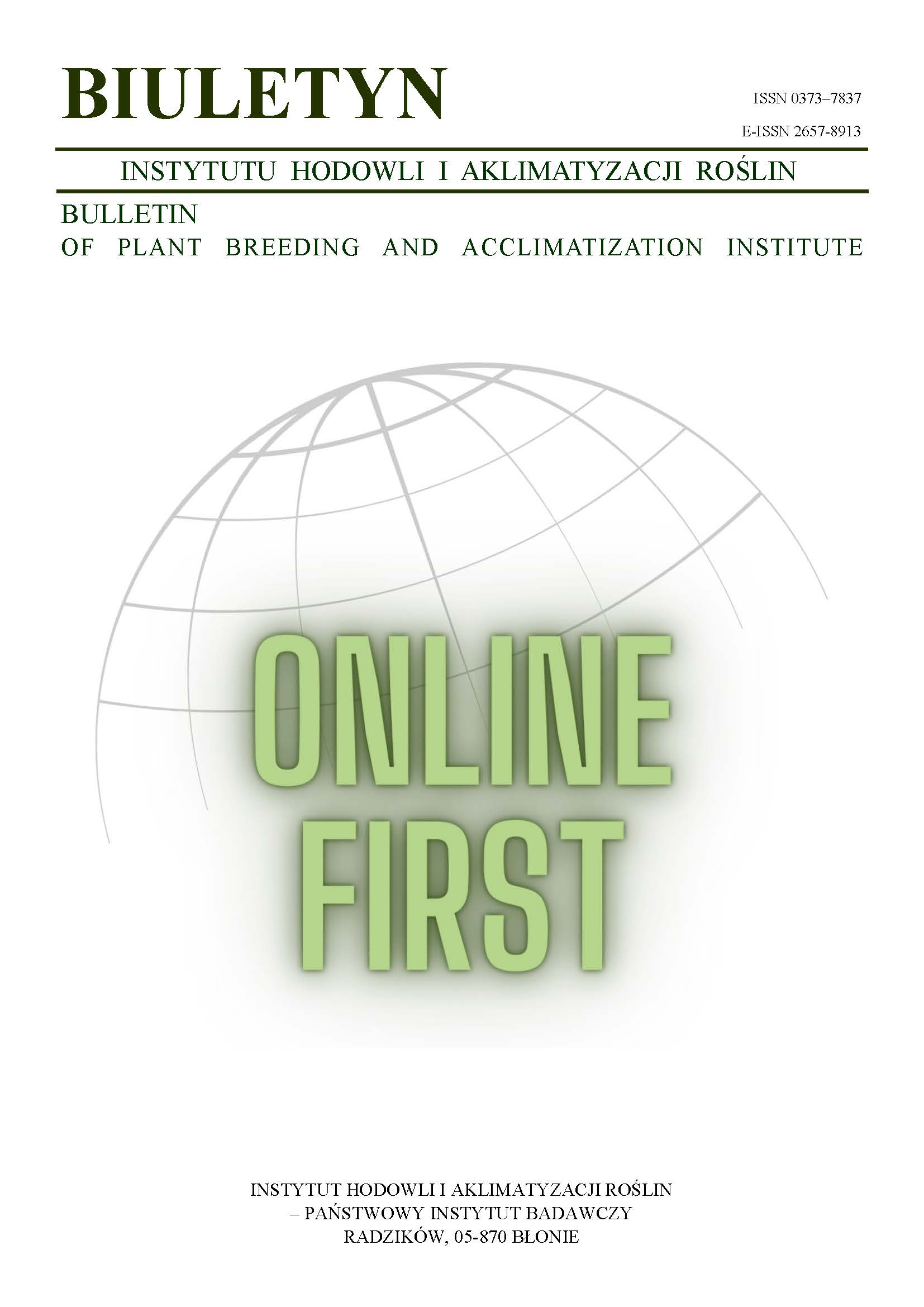The new potato cultivars in seed production
Sławomir Wróbel
s.wrobel@ihar.edu.plZakład Nasiennictwa i Ochrony Ziemniaka w Boninie, Instytut Hodowli i Aklimatyzacji Roślin w Radzikowie (Poland)
Ewa Turska
Zakład Nasiennictwa i Ochrony Ziemniaka w Boninie, Instytut Hodowli i Aklimatyzacji Roślin w Radzikowie (Poland)
Abstract
In the years 2000–2002, tuber infection by viruses was estimated in new registered potato cultivars after 1-year reproduction of healthy seed tubers in the high pressure zone of virus infection (southern Poland). Nine cultivars taken to the experiments: Molli, Gabi, Rumpel, Satina, Zebra, Pasja, Zeus, Skawa and Umiak were compared to the standard cultivars: Drop, Mila and Bzura. The investigations confirmed resistance to PVY infection of the cvs. Gabi, Rumpel, Skawa and Umiak higher (grade 9) than accepted during registration (grade 7.5–8). The qualified cultivars Zebra and Satina were most difficult in potato seed production, while the easiest was the cultivar Skawa. The cultivars Molli, Umiak and Zeus were classified to the second group, which required middle intensive protection against PVY or PLRV, depending on localization of seed production. The cultivars Gabi, Rumpel and Pasja were classified to the third group, where intensive protection against potato leafroll virus is recommended. The cultivar Pasja deserves attention, because of its distinct reaction to the infection by PVS in greenhouse.
Supporting Agencies
References
Głuska A., Zgórska K. 2002. Charakterystyka zarejestrowanych odmian ziemniaka. Wydanie VII. IHAR O/Jadwisin: 17 — 21.
Google Scholar
Hnat A., Turska E., Kaczmarek U., Mosakowska E. 2000. Problem szerzenia się szczepów wirusa Y ziemniaka (PVY) w produkcji nasiennej ziemniaka w Polsce. Hod. Rośl. Nasien. 1: 35 — 40.
Google Scholar
Kostiw M. 2004. Porażenie bulw ziemniaka wirusami Y, M, S i liściozwoju w latach 1989-2000. Nasiennictwo i Ochrona Ziemniaka. Konferencja. Kołobrzeg 4–5.03.2004. ZNiOZ Bonin: 56 — 59.
Google Scholar
Kostiw M., Robak B. 2000. Presja wektorów wirusów Y i liściozwoju w sezonie wegetacyjnym 2000 r. oraz jej wpływ na porażenie tymi wirusami. Ziemniak Polski 3: 29 — 32.
Google Scholar
Kostiw M., Robak B. 2001. Ogólna ocena zagrożenia plantacji nasiennych ziemniaka przez wirusy Y i liściozwoju w 2001 roku. Ziemniak Polski 3: 2 — 7.
Google Scholar
Styszko L. 1993. Znaczenie odmian w nasiennictwie ziemniaka. Zeszyty Naukowe AR Wrocław 223, Rolnictwo LVIII: 355 — 359.
Google Scholar
Świeżyński K. M., Chrzanowska M., Domański L., Zimnoch-Guzowska E. 2001. Comparison of resistance evaluation in potato variety assessment. Potato Research 44: 25 — 31.
DOI: https://doi.org/10.1007/BF02360284
Google Scholar
Turska E. 2000. Nowe odmiany w produkcji nasiennej. Ziemniak Polski 2: 4 — 10.
Google Scholar
Turska E., Wróbel S. 2002. Ochrona plantacji nasiennych ziemniaka — dobór systemu dla różnych odmian. Progress in Plant Protection 42 (2): 685 — 688.
Google Scholar
Turska E., Wróbel S. 2003. Wpływ nawożenia azotem na porażenie wirusami nowych odmian ziemniaka. Progress in Plant Protection 43 (2): 986 — 989.
Google Scholar
Authors
Sławomir Wróbels.wrobel@ihar.edu.pl
Zakład Nasiennictwa i Ochrony Ziemniaka w Boninie, Instytut Hodowli i Aklimatyzacji Roślin w Radzikowie Poland
Authors
Ewa TurskaZakład Nasiennictwa i Ochrony Ziemniaka w Boninie, Instytut Hodowli i Aklimatyzacji Roślin w Radzikowie Poland
Statistics
Abstract views: 11PDF downloads: 5
License
Copyright (c) 2005 Sławomir Wróbel, Ewa Turska

This work is licensed under a Creative Commons Attribution-ShareAlike 4.0 International License.
Upon submitting the article, the Authors grant the Publisher a non-exclusive and free license to use the article for an indefinite period of time throughout the world in the following fields of use:
- Production and reproduction of copies of the article using a specific technique, including printing and digital technology.
- Placing on the market, lending or renting the original or copies of the article.
- Public performance, exhibition, display, reproduction, broadcasting and re-broadcasting, as well as making the article publicly available in such a way that everyone can access it at a place and time of their choice.
- Including the article in a collective work.
- Uploading an article in electronic form to electronic platforms or otherwise introducing an article in electronic form to the Internet or other network.
- Dissemination of the article in electronic form on the Internet or other network, in collective work as well as independently.
- Making the article available in an electronic version in such a way that everyone can access it at a place and time of their choice, in particular via the Internet.
Authors by sending a request for publication:
- They consent to the publication of the article in the journal,
- They agree to give the publication a DOI (Digital Object Identifier),
- They undertake to comply with the publishing house's code of ethics in accordance with the guidelines of the Committee on Publication Ethics (COPE), (http://ihar.edu.pl/biblioteka_i_wydawnictwa.php),
- They consent to the articles being made available in electronic form under the CC BY-SA 4.0 license, in open access,
- They agree to send article metadata to commercial and non-commercial journal indexing databases.
Most read articles by the same author(s)
- Józefa Kapsa, Marek Mrówczyński, Tomasz Erlichowski, Hanna Gawińska-Urbanowicz, Konrad Matysek, Jerzy Osowski, Maria Pawińska, Janusz Urbanowicz, Sławomir Wróbel, Potato protection according to the principles of integrated pest management. Part II. Sustainable method of chemical potato protectio , Bulletin of Plant Breeding and Acclimatization Institute: No. 273 (2014): Regular issue
- Józefa Kapsa, Marek Mrówczyński, Tomasz Erlichowski, Hanna Gawińska-Urbanowicz, Konrad Matysek, Jerzy Osowski, Maria Pawińska, Janusz Urbanowicz, Sławomir Wróbel, Potato protection according to the principles of integrated pest management. Part I. Non-chemical methods of protection , Bulletin of Plant Breeding and Acclimatization Institute: No. 273 (2014): Regular issue
- Sławomir Wróbel, Effects of fertilization of potato cultivar Jelly with foliar fertilizers YaraVita Ziemniak and Actisil , Bulletin of Plant Breeding and Acclimatization Institute: No. 266 (2012): Regular issue
- Sławomir Wróbel, Barbara Robak, New potato cultivars characterized in regard to dormancy breaking of tubers , Bulletin of Plant Breeding and Acclimatization Institute: No. 272 (2014): Regular issue
- Sławomir Wróbel, Adjuvants in seed potato protection against PVY and PVM infection , Bulletin of Plant Breeding and Acclimatization Institute: No. 259 (2011): Regular issue
- Janusz Urbanowicz, Sławomir Wróbel, Response of potato plants of the cultivar Mila to some adjuvants used in seed crop protection , Bulletin of Plant Breeding and Acclimatization Institute: No. 237/238 (2005): Regular issue
- Sławomir Wróbel, Optimal agro-practices to control PVY in potatoes , Bulletin of Plant Breeding and Acclimatization Institute: No. 237/238 (2005): Regular issue
- Sławomir Wróbel, Ewa Turska, Possibility of application of bed planting in seed potato production , Bulletin of Plant Breeding and Acclimatization Institute: No. 232 (2004): Regular issue
- Sławomir Wróbel, Influence of different methods of haulm killing on rate of haulm desiccation and tuber yield of mid-early potato seed plantations , Bulletin of Plant Breeding and Acclimatization Institute: No. 237/238 (2005): Regular issue














